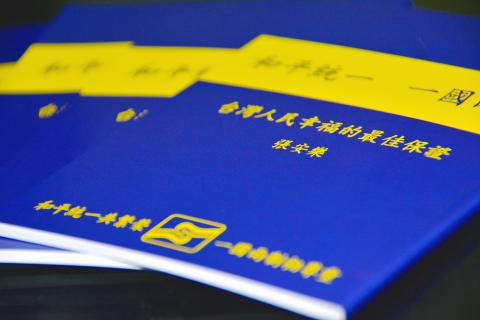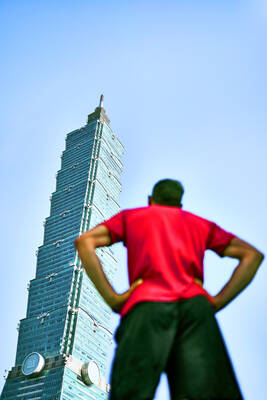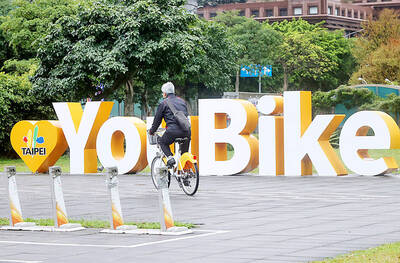Ever since his return to Taiwan late last month, Chang An-le (張安樂), a wanted fugitive and former leader of the Bamboo Union triad, has sought to remind people in Taiwan that he has written a booklet promoting the “peaceful re-unification” of Taiwan and China.
Even when a SWAT team picked him up at Taipei International Airport (Songshan airport) after he disembarked from an airplane from Shanghai on June 29, the handcuffed Chang was able to display his political tract so that the dozens of photographers and journalists who had gathered to cover his return could catch it on film and report it.
Soon after he was released on NT$1 million (US$33,000) bail that same day, the “White Wolf” — as he is called in the underworld — started appearing on TV talk shows desperate for a ratings boost, where besides promoting his political views and demonstrating just how out of touch with Taiwan’s political scene he has become after an absence of 17 years, he made sure to flash the booklet.

Photo: J. Michael Cole, Taipei Times
After the repeated appearances the pamphlet, Peaceful Unification and One County (和平統一、一國兩制), has made in the weeks since his return, I decided to obtain a copy to see what I could learn about Chang’s plans for the future of China and Taiwan, especially now that the Unionist Party he created while he was exiled in China has stated its intention to field candidates in next year’s local elections, and perhaps even in the 2016 presidential election.
I needed to see what Chang, who served 10 years in jail in the US for drug trafficking and who played a role in the 1984 assassination of journalist Henry Liu (劉宜良) in California, had to say about his plans for unification.
Another reason I wanted to sample the literature stemmed from the high likelihood that the Chinese Community Party’s (CCP) United Front efforts to solve the “Taiwan problem” include using criminal organizations. With Chang now a free man — given that no date appears to have been set for his trial and his close relationship with some political figures in China and Taiwan — I was curious to find out whether he might be part of such efforts by the CCP.
Although it is impossible to verify his sources, exiled Chinese writer Yuan Hongbing (袁紅冰) claims in his book, The Taiwan Crisis, to have come upon high-level classified information confirming the role of organized crime in Beijing’s “reunification” efforts.
The Unionist Party’s office is located in Taipei’s Songshan District (松山). On my way there last week, I did not know what to expect, but I vividly remembered the assortment of characters that had gathered by the hundreds on June 29 to celebrate Chang’s return.
When I reached the nondescript building, I scanned the various company signs displayed in the lobby and found that party’s office was still there, on the fourth floor. I went up in the cramped elevator, various scenarios — some rather violent, albeit newsworthy — playing through my head.
It was very likely that I was the first foreigner ever to visit the party headquarters, and based on my previous experiences with pro-unification figures in Taiwan, they tend to have a bit of a xenophobic streak.
A woman passing by regarded me with a strange expression on her face as I walked toward the closed glass front door, where a large yellow-and-blue sign bearing a logo of two clasped hands — ostensibly representing the warmth of the people on both sides of the Taiwan Strait — confirmed that I had reached my destination.
I pressed the ringer, not knowing whether there would be anyone there. It was 11:45am, but the UP is not the Chinese Nationalist Party (KMT) or the Democratic Progressive Party — a lot of people in Taiwan are not even aware of its existence.
There was no answer, but at 1.83m tall, I was able to look in through the top section of the door that was not smoked glass. A man, somewhere in his sixties, was seated at a desk at the far corner of the room, speaking on the telephone. No lovely receptionist at the UP — at least not yet.
I pushed the door and it offered no resistance. After I had waited for a minute or so, the man concluded his call and came over, greeting me in Mandarin. I replied that I was a journalist and was wondering whether they had copies of the booklet that Chang had been promoting.
“Of course, of course,” the man said, ushering me into a conference room on my left, where he left me alone as he went back to his desk.
The otherwise empty room had two salient features: a large People’s Republic of China (PRC) flag, which contrasted sharply with the egg-white walls, and a large collection of photographs — hundreds of them — pasted on a wall showing Chang in various places he had visited in China, along with the many influential CCP figures he had brushed elbows with over the years.
This was one of those moments when I regretted not bringing my camera, but then again, I am not sure how the staff would have reacted if I had started snapping pictures with my Nikon.
My host promptly returned, holding a small stack of the booklets I had requested, though they were smaller than the one Chang had flashed on TV. He then escorted me to another door at the far end of the conference room, which gave way to another office.
In there, another man was seated at a desk — larger, made of finer wood, which I guessed meant he was a more important figure within the party — sucking on a cigarette.
My first instinct was to remind him that under Taipei City Government regulations, it was illegal to smoke inside commercial buildings, but I thought better of it.
The man, who was in his fifties, short, slightly overweight, with stained teeth, looked more the kind of person who had given Chang a bad reputation in the 1980s — in other words, more like a gangster — than the political staffer that one expects to see at a party’s headquarters.
He stood up from behind his desk and I greeted him, repeating that I was a journalist hoping to get some of the UP’s literature.
“How many do you want?” he asked in Mandarin.
“Would two be all right?” I asked.
“Have five — six,” he said.
They gave me five, which the man in his sixties placed inside a yellow envelope, either for convenience or to hide the contents.
We stood there in silence and the pair seemed to be waiting for me to ask them questions. Since I had a previous engagement, I told them that all I wanted for the time being was a copy of their booklet so I could familiarize myself with Chang’s vision.
They escorted me out, the short man smiling and thanking me profusely, his left hand cupping his right fist and shaking up and down, a symbol of gratitude in this part of the world.
“You wouldn’t happen to have an English-language version?” I asked.
“Sorry, only Chinese. You understand Chinese, right?” the shorter man said.
“Yes,” I replied as I made for the door.
We said goodbye and I left.
They were polite, welcoming. Interestingly, they never asked me which media organization I worked for, nor did they ask for a business card or some confirmation that I was a reporter. Maybe they need good publicity, given the political ambitions of Chang, who is now promoting himself as a sort of high priest of unification.
As for the 48-page booklet (the last two pages are blank, for note-taking), parts of it read as if it had been penned by Chang’s grandson, with one passage stating: “Taiwanese who oppose unification are like an ostrich... When Taiwan and China are reunited, China will be friends with the entire world.”
Chang’s booklet is borderline silly and its contents are unlikely to convince many Taiwanese of the benefits of unification. The White Wolf has plans for Taiwan, but his plans hardly reflect what its 23 million people hope for their future.

US climber Alex Honnold is to attempt to scale Taipei 101 without a rope and harness in a live Netflix special on Jan. 24, the streaming platform announced on Wednesday. Accounting for the time difference, the two-hour broadcast of Honnold’s climb, called Skyscraper Live, is to air on Jan. 23 in the US, Netflix said in a statement. Honnold, 40, was the first person ever to free solo climb the 900m El Capitan rock formation in Yosemite National Park — a feat that was recorded and later made into the 2018 documentary film Free Solo. Netflix previewed Skyscraper Live in October, after videos

Starting on Jan. 1, YouBike riders must have insurance to use the service, and a six-month trial of NT$5 coupons under certain conditions would be implemented to balance bike shortages, a joint statement from transportation departments across Taipei, New Taipei City and Taoyuan announced yesterday. The rental bike system operator said that coupons would be offered to riders to rent bikes from full stations, for riders who take out an electric-assisted bike from a full station, and for riders who return a bike to an empty station. All riders with YouBike accounts are automatically eligible for the program, and each membership account

A classified Pentagon-produced, multiyear assessment — the Overmatch brief — highlighted unreported Chinese capabilities to destroy US military assets and identified US supply chain choke points, painting a disturbing picture of waning US military might, a New York Times editorial published on Monday said. US Secretary of Defense Pete Hegseth’s comments in November last year that “we lose every time” in Pentagon-conducted war games pitting the US against China further highlighted the uncertainty about the US’ capability to intervene in the event of a Chinese invasion of Taiwan. “It shows the Pentagon’s overreliance on expensive, vulnerable weapons as adversaries field cheap, technologically

NUMBERS IMBALANCE: More than 4 million Taiwanese have visited China this year, while only about half a million Chinese have visited here Beijing has yet to respond to Taiwan’s requests for negotiation over matters related to the recovery of cross-strait tourism, the Tourism Administration said yesterday. Taiwan’s tourism authority issued the statement after Chinese-language daily the China Times reported yesterday that the government’s policy of banning group tours to China does not stop Taiwanese from visiting the country. As of October, more than 4.2 million had traveled to China this year, exceeding last year. Beijing estimated the number of Taiwanese tourists in China could reach 4.5 million this year. By contrast, only 500,000 Chinese tourists are expected in Taiwan, the report said. The report